Greetings, Conscientious Food Consumers!
Another pandemic milestone is fast approaching — Halloween without much trick-or-treating. Thank goodness pumpkin carving is still CDC-approved! So is, we assume, National Pumpkin Day on October 26th.
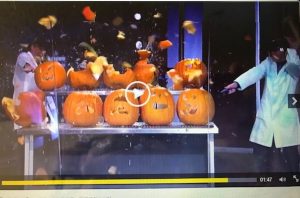 The season of the jack-o-lantern brings to mind one of my (and my kiddo’s) favorite bits of macabre Halloween hilarity — Science Bob’s exploding pumpkins experiment on the Jimmy Kimmel Show. Admittedly, it was also a frivolous waste of pumpkin innards, including all those nutritious seeds…
The season of the jack-o-lantern brings to mind one of my (and my kiddo’s) favorite bits of macabre Halloween hilarity — Science Bob’s exploding pumpkins experiment on the Jimmy Kimmel Show. Admittedly, it was also a frivolous waste of pumpkin innards, including all those nutritious seeds…
Did you know? Pumpkin guts are good for you!
In addition to its dense flesh containing essential vitamins, beta carotene, and minerals such as calcium, the pumpkin’s oval seeds are packed with a surprising amount of protein, fiber and omega fatty acids, as well as anti-oxidants and nerve-calming magnesium. Here’s an outline of the health benefits associated with pumpkin seeds from the BBC’s “Good Food” website.
So don’t toss (or compost) those punkin’ guts! (Slimy-stringy guts, ok.) It will take a bit of time and effort, but the reward will be a healthy, versatile snack that you made yourself — while saving a few $$$ you may have otherwise spent on fancy packaged trail or nut mixes.
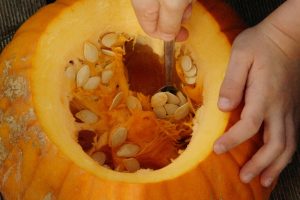 As usual, we turn to the OSU Master Food Preserver program for the definitive how-to on Drying and Roasting Seeds for pumpkins, other squash and for sunflowers as well. The process involves these basic steps:
As usual, we turn to the OSU Master Food Preserver program for the definitive how-to on Drying and Roasting Seeds for pumpkins, other squash and for sunflowers as well. The process involves these basic steps:
- DIG ‘EM out, CLEAN ‘EM and DRY ‘EM well in the oven or dehydrator;
- Add seasonings, oil and ROAST ‘EM in their white outer hulls (being careful to not over-cook them),
UNLESS:
-
- You really want just the tender and green inner seed (known as a “pepita“) — particularly to make the seeds easier for younger kids to eat. Then you’ll be doing the extra work to remove the tough and fibrous outer seed hull before continuing on to the frying or roasting. If you prefer, prepare a batch to use soon and eat raw.
THEN:
-
- SNACK ON ‘EM as is, or THROW ‘EM in your salads, muffins, breakfast cereal, trail mix, what have you! STORE ‘EM in an airtight container in your fridge or freezer (not the pantry, where they will likely turn rancid).
A bit of clarification regarding carving pumpkins, a.k.a. “jack-o-lanterns” versus their non-exploding cousins the “pie pumpkins” which provide the best tasting “innards” for your winter and holiday dishes. Carving pumpkins are grown for their size and tend to have unpleasant-tasting flesh, while the smaller pie pumpkins are cultivated primarily for culinary uses. Right now you might be getting ready to do some pumpkin PREP to:
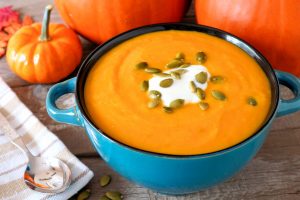
- PRESERVE/FREEZE ‘EM, referring to these expert pumpkin preservation and preparation tips from OSU Extension Service. (Make sure to note the items on our handy, downloadable Freezer Inventory and Meal Planner!)
- STORE ‘EM properly in the pantry or fridge; track their consume-ability and get help for burning questions like “How long does pumpkin bread last?” or “How long do pumpkin seeds last?” from StillTasty.com’s searchable database;
- USE ‘EM in desserts, soups, cookies and other baked items, and check StillTasty.com regarding food safety guidelines.
Don’t forget the pumpkin’s winter squash relatives — the striped and speckled delicatas, spaghettis, acorns, butternuts, Hubbards, etc. — in your prep, preservation and seasonal meal planning!
HAVE KIDDOS? They’ll probably jump at the chance to get their hands in some “pumpkin guts” or puree to help you make kid-friendly recipes like Jack-O-Lantern Pancakes, pumpkin pudding or even fruit dip. They’re all part of FoodHero.org, a bilingual collection of nutrition learning resources from OSU Extension Service’s Family and Community Health Program.
On their pumpkin home page, kids will find videos, coloring sheets, infographics and even jokes! The “Pumpkin Basics” infographic introduces key facts and messages such as “Store well, waste less” — which we love seeing!
*****
And now for this week’s Kitchen Confession:
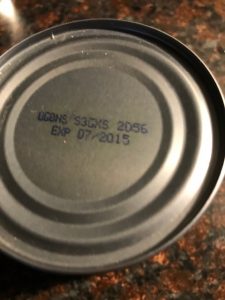
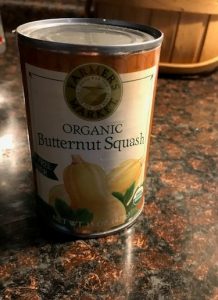
KAREN CONFESSES: This can of butternut squash was once intended as the main ingredient for a nice soup, but got “left behind” in a secondary pantry storage area that I hadn’t inventoried until… this year!
Although StillTasty.com advises that it is still safe to eat as long as the can is undamaged and its seals intact, I didn’t feel comfortable using it.
$$$ WASTED: $2.49
LESSON LEARNED: Consolidate and reorganize my pantry storage by placing older items in front of those with a longer “Best by” date. Check for other items nearing their date and transfer to upcoming Meal Plans!
“Local Eats Month” is underway in Corvallis, with special menu offerings at selected local restaurants celebrating the farmers and foods produced within our six-county region. Between October 18 – November 14, check “Sustainable Corvallis” on Facebook for announcements from the Food Action Team about the latest specials from participating restaurants. On Instagram: @sustainablecorvallis


